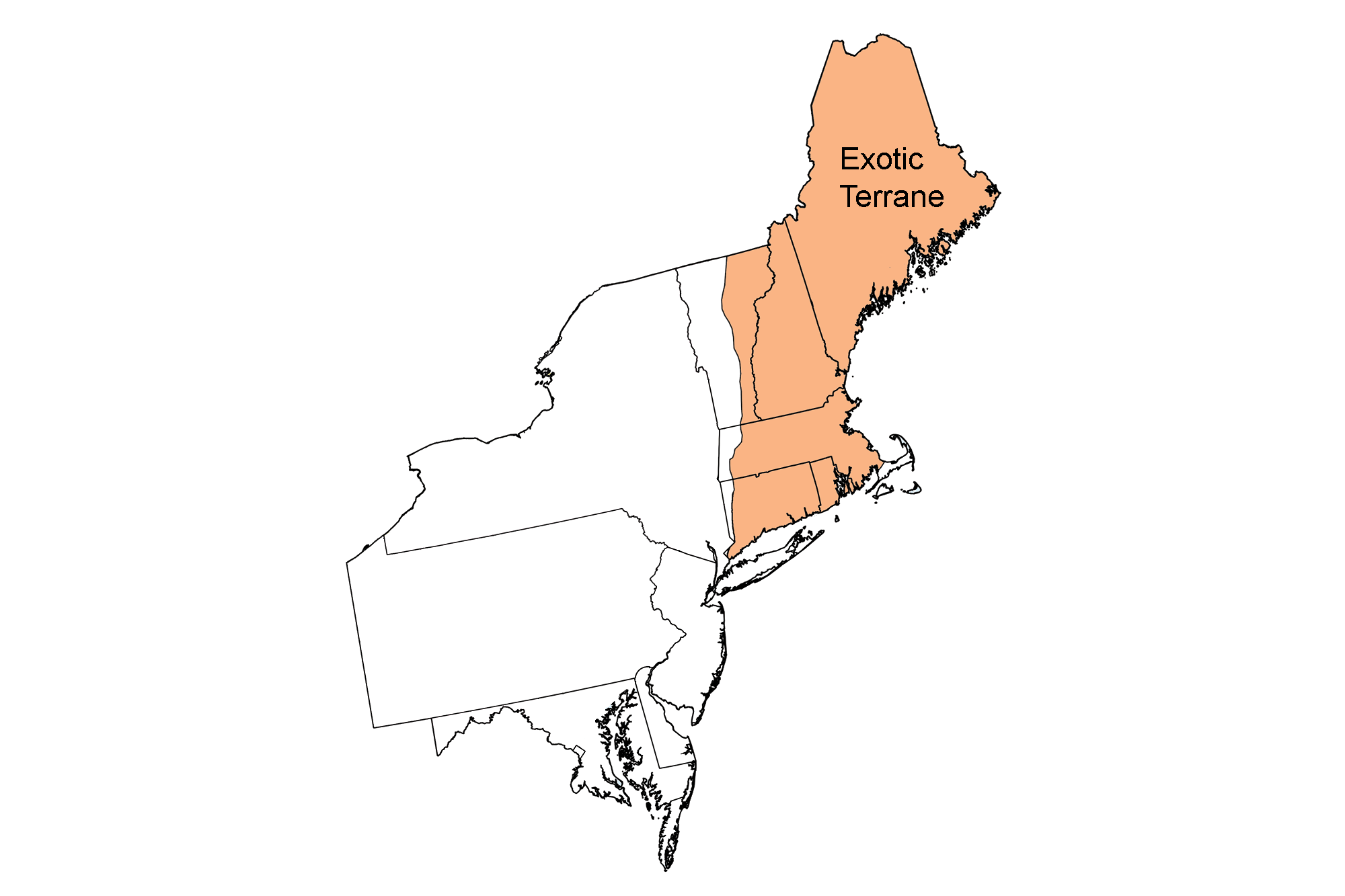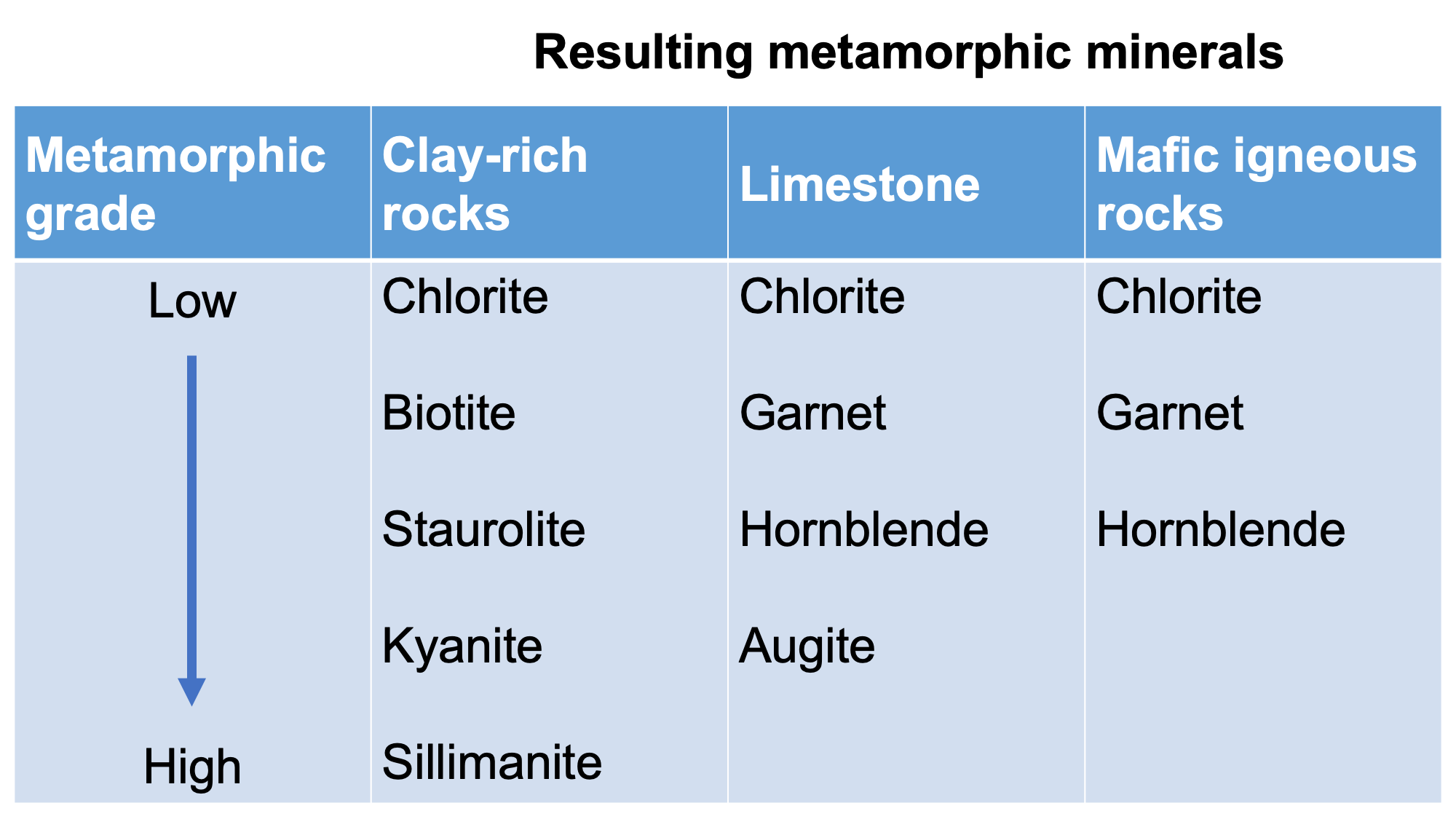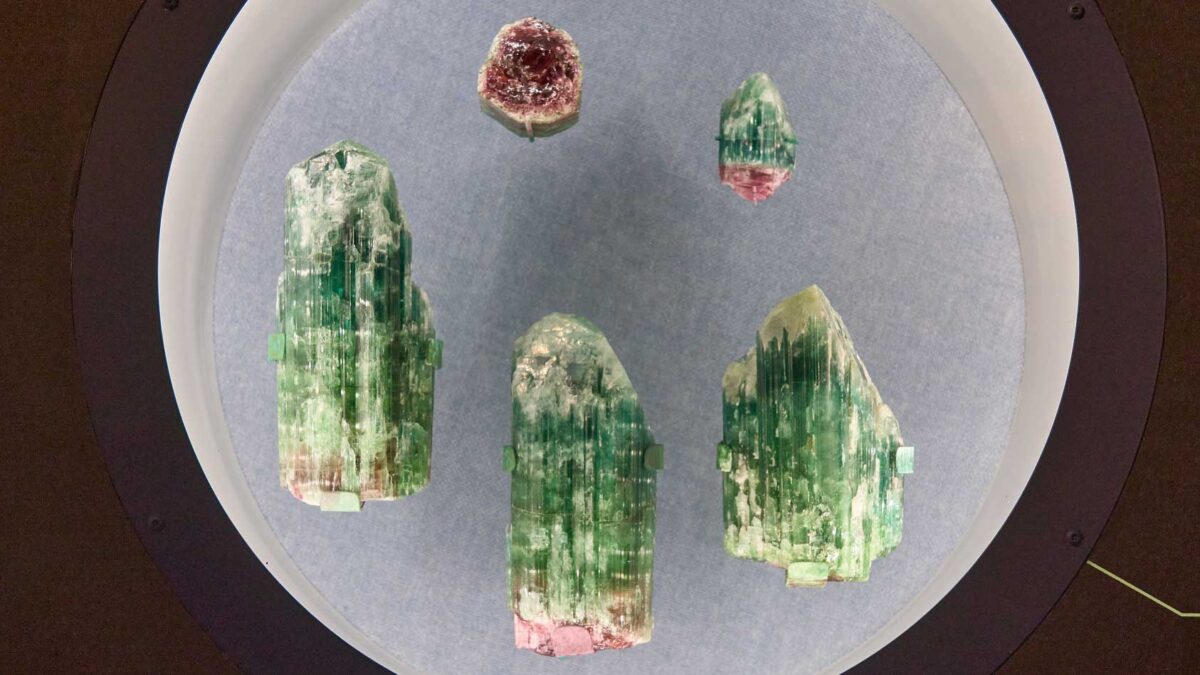Snapshot: Overview of the mineral resources of the Exotic Terrane region of the northeastern United States.
Topics covered on this page: Overview; Metallic Resources; Non-Metallic Resources; Resources.
Credits: Most of the text of this page is derived from "Mineral resources of the Northeastern US" by Jane E. Ansley, chapter 6 in The Teacher-Friendly Guide to the Geology of the Northeastern U.S. (published in 2000 by the Paleontological Research Institution). The book was adapted for the web by Andrielle Swaby, Elizabeth J. Hermsen, and Jonathan R. Hendricks. Changes include formatting and revisions to the text and images. Credits for individual images are given in figure captions.
Updates: Page last updated September 28, 2023.
Image above: Samples of multicolored tourmaline from Maine. Photograph by Graeme Churchard (Flickr; Creative Commons Attribution 2.0 Generic license; image cropped and re-sized).

Overview
The formation of the igneous and metamorphic rocks that dominate the Exotic Terrane region provided the perfect conditions for spectacular concentrations of metallic and non-metallic minerals. The first chartered mining company in the US started in the Exotic Terrane region in 1709 at the Simsbury Copper Mine, Connecticut (now East Gransby, CT). Other very early mines were located in the Blue Hills along coastal Maine.
Metallic Resources
With the collision of the Taconic volcanic islands in the Ordovician, Baltica and Avalonia in the Devonian, and the final collision with Africa during the Permian, the various slices of the Exotic Terrane region have undergone significant periods of compression, deformation, metamorphism and intrusion by magmas. These dynamic geologic conditions gave rise to the formation of many metallic minerals (often associated with igneous and metamorphic rocks). Granite pegmatites, common in this area, often include uranium, gold, antimony, graphite, and iron. Gold, lead, silver and copper are associated with the metamorphic rocks in the region and commonly found in association with one another.
Exceptionally fine quality crystals of pyrite, ‘fools gold,’ are found in Chester, Vermont. A very common and widespread mineral, pyrite forms in igneous, metamorphic and sedimentary environments as well as through the chemical alteration of other minerals. Other metallic minerals and ores found in the Exotic Terrane region include molybdenum, cobalt, nickel, tin, and tungsten. The largest manganese deposit on the North American continent is found in Maine in Silurian rocks of Aroostook County. The mildly metamorphosed Silurian rocks were once sediments at the bottom of the Iapetus Ocean. Concentrations of manganese commonly form on ocean bottoms today.
Non-Metallic Resources
The primary non-metallic minerals of the region are metamorphic and pegmatite minerals, which are so common in the Exotic Terrane area because of the foundation of igneous and metamorphic rock.
Metamorphic rocks
The process of metamorphism ranges from low grade (with only mild increases in pressure and temperature) to high grade (with severe increases in pressure and temperature). Mildly deformed rocks may be subjected to very low grades of metamorphism and outwardly exhibit little change in appearance. Severely deformed rocks, on the other hand, have usually been subjected to very high grades of metamorphism and appear distinctly different. The higher the degree of metamorphism, the greater the change is to the original rock. The changes include, to varying degrees, the alignment of minerals within the rock, recrystallization of minerals, and, in many cases, the crystallization of new minerals.
Geologists have determined that specific minerals will form at specific temperature and pressure conditions when a given type of rock is metamorphosed. Low-grade metamorphism of clay-rich rocks such as shale, produce the mineral chlorite. Higher-grade increased metamorphism produces the minerals kyanite and sillimanite. The minerals associated with certain grades of metamorphism are known as index minerals, indicative of the combination of the temperature and pressure conditions a rock has undergone.

Minerals formed through varying degrees of metamorphism in different types of rocks. Image by Jonathan R. Hendricks for the Earth@Home project.
Thus, by examining the minerals found in the Exotic Terrane region, it is clear that the rocks have been metamorphosed to varying degrees. Chlorite is found in northern Maine, indicating that the rocks were only mildly deformed because they were not the center of the collision between continents and have fewer igneous intrusions. Eastern New Hampshire and southern Maine, however, clearly show evidence of high-grade metamorphism by the presence of minerals such as sillimanite and kyanite.
Considering the plate tectonic history of the Exotic Terrane region, the presence of high-grade metamorphism in the rocks is no surprise. The rocks with high-grade metamorphic minerals indicate the area of greatest stress during the episodes of mountain building throughout the Paleozoic, as well as areas that have been intruded by magma.
Garnet, a metamorphic mineral indicative of moderate metamorphism, is found throughout the Exotic Terrane region. Connecticut has spectacular garnets in the metamorphic rock, mica schist. Garnet is used as a gemstone and an abrasive in sandpaper and polishing. The substitution of different elements into the crystal structure produces several common types of garnets, all of which have the same basic chemical composition: uvarovite, pyrope, andradite, almandite, grossularite and spesartite. Almandite is particularly common in Connecticut.
Gemstones and other non-metallic minerals
The plate tectonic history of the Exotic Terrane region provided the right conditions to produce slow-cooling magmas far below the surface. Volatiles escaping from those deep magma chambers, enriched in water and rare elements, led to the creation of outstanding pegmatites: lithium pegmatites in Massachusetts; phosphate pegmatites in New Hampshire; and the famous gem-quality tourmalines and beryl of Maine. The first Maine tourmaline, and the start of gemstone production in the United States, was mined at Mt. Mica, where crystals have been found as large as 39.4 cm long, 17.8 cm wide and weighing 14.3 kg.

Long crystal of elbaite tourmaline from Maine. Photograph by James St. John (Flickr; Creative Commons Attribution 2.0 Generic license).
Many minerals in a pegmatite are common and not gem quality, such as quartz, mica, and feldspar. However, gemstones frequently are found in association with pegmatites. Other gemstones found in the Exotic Terrane region include garnet, zircon, topaz, corundum, feldspar, and quartz varieties including jasper, rock crystal, amethyst, and smoky, rose and clear quartz.
Resources
Resources from the Paleontological Research Institution
Digital Atlas of Ancient Life: Minerals (collection of 3D models on Sketchfab): https://skfb.ly/6WxTo
Digital Encyclopedia of Earth Science: Minerals: https://earthathome.org/de/minerals/



